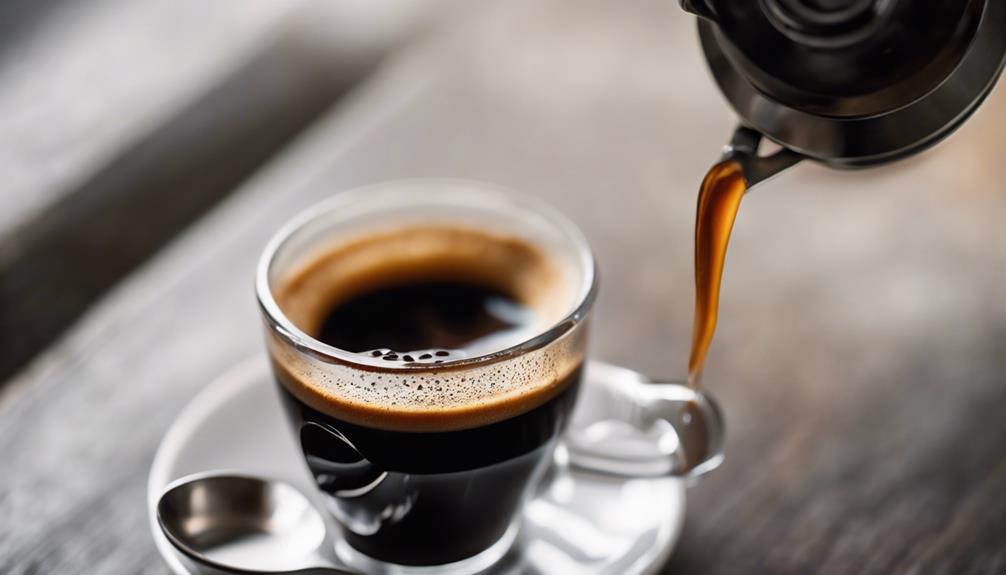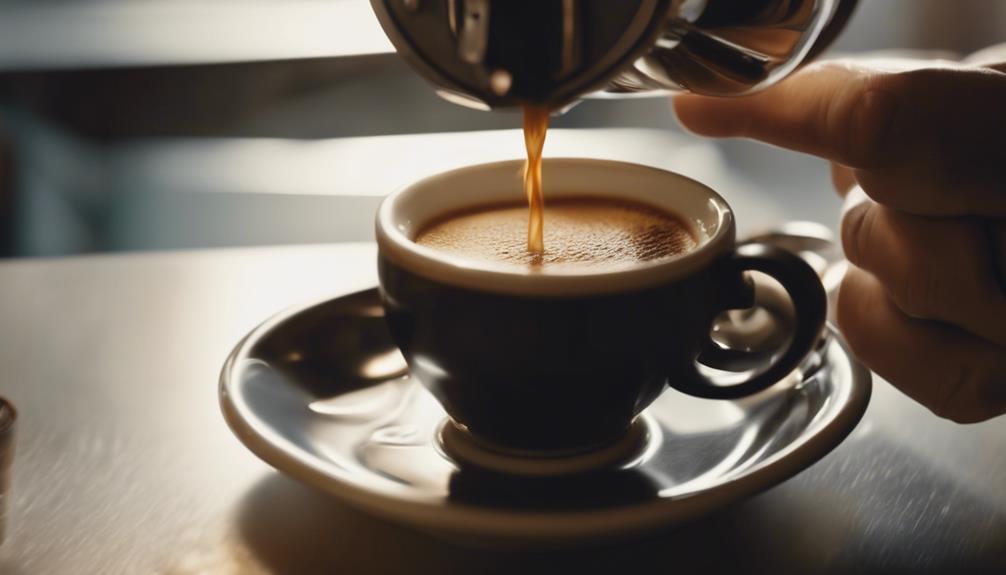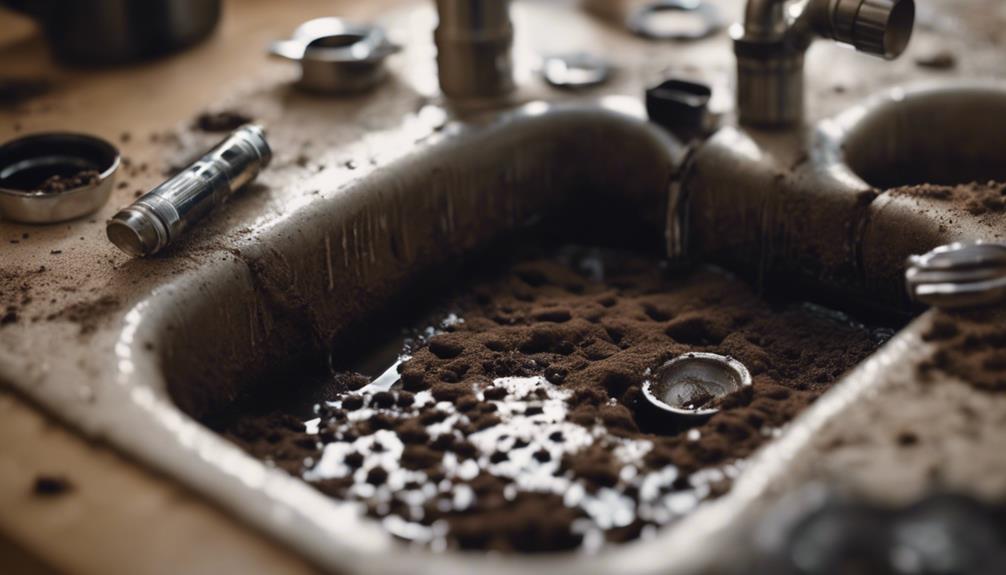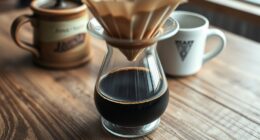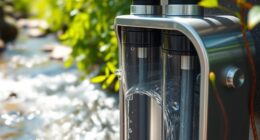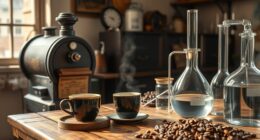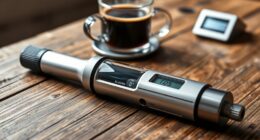You are on the verge of receiving an accurate answer to the question that has sparked your curiosity: a standard 1-ounce espresso shot contains approximately 63 milligrams of caffeine. This quantity may vary depending on factors such as coffee bean type, roast level, and brewing time. However, this is just the beginning – as you delve into the realm of espresso, you will learn how these elements affect the caffeine content and flavor profile of your preferred shots. Prepare to uncover the intricacies of espresso and how you can enhance your caffeine boost.
Key Takeaways
- A standard 1-ounce espresso shot contains approximately 63 mg of caffeine.
- Caffeine levels vary based on coffee bean type, with Robusta beans containing higher caffeine than Arabica beans.
- The brewing method, including factors like grind size, pressure, and time, influences final caffeine content.
- Espresso roast level affects caffeine retention, with lighter roasts generally retaining more caffeine than darker roasts.
Caffeine Content in Espresso
When you order a standard 1-ounce shot of espresso, you can expect to get approximately 63 milligrams of caffeine, although this amount can vary depending on several factors. The type of coffee beans used plays a significant role in determining the caffeine content. For instance, Robusta beans generally contain more caffeine than Arabica beans, which can affect the overall caffeine levels in your espresso shot.
If you opt for a double shot, which is 2 ounces, you can expect around 126 milligrams of caffeine, effectively doubling the concentration of caffeine.
It's worth noting that the brewing method also impacts the final caffeine content. The grind size of the coffee, brewing pressure, and brewing time all contribute to the extraction of caffeine.
If you were to hypothetically brew an 8-ounce serving of espresso, you'd get around 504 milligrams of caffeine, highlighting the high concentration of caffeine in espresso compared to brewed coffee.
Understanding these factors can help you make informed decisions about your caffeine intake and appreciate the complexity of your favorite espresso shot.
Factors Affecting Caffeine Levels
As you explore the world of espresso, you'll discover that the caffeine levels in your shot are influenced by several key factors.
You'll find that the type of coffee bean you use, the level of roasting, and the brewing time all play a significant role in determining the caffeine content of your espresso.
Bean Type Matters
You'll notice a significant difference in caffeine levels depending on the type of coffee bean used, with Robusta beans packing a heavier caffeine punch than Arabica beans. This is because Robusta beans contain approximately 2.2-2.7% caffeine, while Arabica beans typically have about 1.2-1.5% caffeine content. As a result, espresso made from Robusta beans can yield a caffeine content of around 75-100 mg per shot, compared to 60-75 mg for espresso made from Arabica beans.
Here are some key factors to keep in mind when it comes to bean type and caffeine levels:
- Bean type: Robusta beans have a higher caffeine content than Arabica beans.
- Caffeine content: Robusta beans contain 2.2-2.7% caffeine, while Arabica beans contain 1.2-1.5% caffeine.
- Espresso shot: Espresso made from Robusta beans can have up to 100 mg of caffeine per shot.
- Roasting process: Lighter roasts generally retain slightly more caffeine than darker roasts.
Roast Level Impact
Your coffee bean selection is just the starting point, since the roast level of those beans also plays a significant role in determining the caffeine content of your espresso shot.
As you explore the world of espresso, you'll discover that lighter roasts generally contain more caffeine than darker roasts. This is because caffeine breaks down during the roasting process, resulting in a 10-15% decrease in caffeine content for darker roasts.
While the difference may seem marginal, it's essential for caffeine seekers who want to maximize their energy boost. The roast level not only affects caffeine retention but also the overall flavor profile and strength of the coffee.
Since espresso is often made from dark roasted beans, it may have a lower caffeine content than lighter roasted espresso, despite the concentration in a smaller serving size.
When choosing your espresso, remember that the roast level can impact the brewing experience. Experiment with different roast levels to find the perfect balance of flavor and caffeine content for your taste buds.
Brewing Time Effects
The brewing time for an espresso shot is critical, and even slight variations can greatly impact the final caffeine concentration and flavor profile of your shot. You might be surprised at how much of a difference a few seconds can make. Here's what you need to know:
Ideal brewing time: The ideal brewing time ranges from 25 to 30 seconds, which allows for optimal caffeine extraction without over-extracting the coffee.
Longer brewing times: Brewing for too long can lead to over-extraction, resulting in bitter flavors, but may somewhat increase the caffeine content.
High pressure: The 9 bars of pressure used in espresso brewing enhance the efficiency of caffeine extraction within the short brewing time.
Standard shot: A correctly brewed 1-ounce shot of espresso typically contains around 63 mg of caffeine due to the precise timing and pressure involved. The caffeine content in espresso can vary depending on factors such as the type of coffee bean used and the brewing method. Some espresso shots can contain as little as 30 mg of caffeine, while others can contain up to 100 mg or more. It’s important to keep in mind that the caffeine content in espresso can also be affected by the size of the shot and the roast of the coffee beans used.
Variations matter: Even slight variations in brewing time can greatly impact the final caffeine concentration and overall flavor profile of your espresso.
Espresso Vs. Regular Coffee
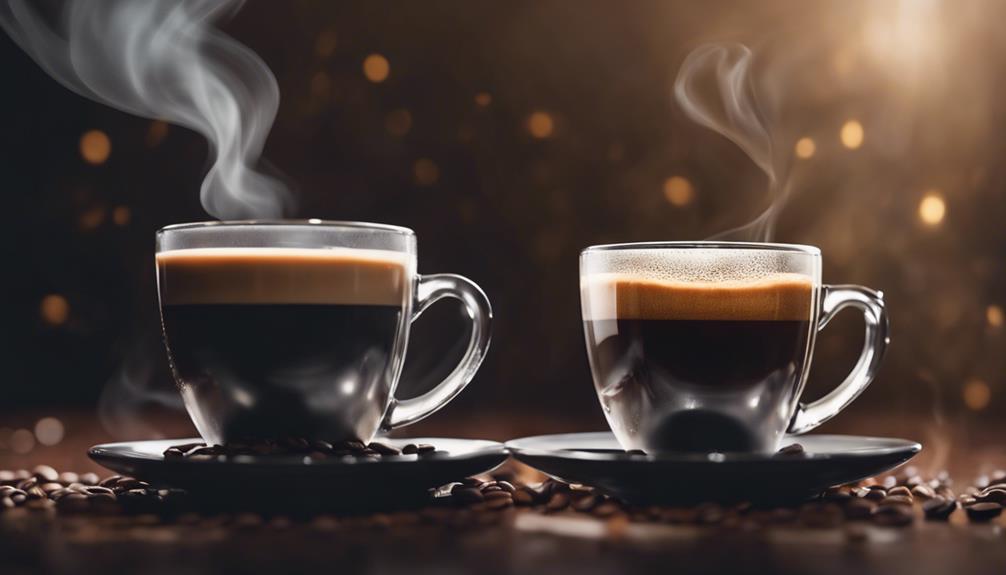
When you're deciding between an espresso and a regular cup of coffee, you're likely wondering what sets them apart.
You might assume it's just the amount of caffeine, but there's more to it – the type of coffee beans used, the brewing methods, and the resulting caffeine content all play a role.
As you explore the differences between espresso and regular coffee, you'll learn how these factors impact your daily caffeine fix.
Espresso Bean Differences
Diving into the world of coffee, you'll find that espresso beans aren't always a distinct breed, but rather regular coffee beans that have undergone a transformation to bring out their unique flavor and characteristics. This transformation involves roasting them longer and grinding them more finely to create a concentrated flavor profile.
Here are some key differences between espresso beans and regular coffee beans:
- Espresso beans can be derived from both Arabica and Robusta coffee varieties, but Robusta beans generally contain more caffeine.
- The grind size for espresso is vital; a finer grind increases surface area for extraction, which enhances the strength and caffeine concentration in the final product.
- Espresso preparation involves forcing hot water through finely-ground coffee at high pressure, resulting in a thicker and richer drink compared to regular coffee brewing methods.
- Espresso beans are typically roasted longer to bring out a deeper flavor, which is essential for the espresso preparation method.
Caffeine Content Compared
You're likely wondering how the caffeine content of your espresso shot stacks up against a regular cup of coffee. Let's examine and compare the two.
| Beverage | Serving Size | Caffeine Content (mg) |
|---|---|---|
| Espresso Shot | 1 oz | 63 |
| Double Espresso Shot | 2 oz | 126 |
| Cup of Brewed Coffee | 8 oz | 95-200 |
| Cup of Brewed Coffee (avg) | 8 oz | 95 |
| Cup of Brewed Coffee (max) | 8 oz | 200 |
As you can see, an espresso shot packs a concentrated punch of caffeine, but a typical serving of brewed coffee provides more total caffeine due to its larger volume. The caffeine content in espresso can vary based on factors like coffee bean type, grind size, and brewing technique, but it generally remains lower in total caffeine than a standard serving of brewed coffee. For coffee drinkers, understanding the caffeine levels in their daily cup can be essential. Whether you prefer the rich, bold flavor of espresso or the smooth taste of brewed coffee, knowing the milligrams per serving can help you make informed choices about your daily caffeine intake.
Brewing Methods Impact
The distinct brewing methods behind espresso and regular coffee greatly impact their caffeine content and flavor profiles. As you explore the differences between these two popular beverages, you'll notice that the brewing process plays a significant role in the final product.
Here are some key factors to take into account:
- Pressure and grind size: Espresso's high-pressure brewing method (9 bars) and fine grind size increase the surface area, allowing for better caffeine extraction.
- Brewing time: Espresso's quick 25-30 second brewing time contrasts with regular coffee's longer brewing time, affecting the total caffeine extraction and flavor profile.
- Caffeine concentration: Espresso's concentrated shot packs approximately 63 mg of caffeine per 1-ounce serving, while regular coffee averages about 95 mg per 8-ounce cup.
- Extraction efficiency: Espresso's fine grind and high pressure result in a more efficient caffeine extraction, making it a more potent beverage.
Caffeine in Espresso-Based Drinks
On average, your favorite espresso-based drinks contain a surprising amount of caffeine, with lattes and cappuccinos leading the pack.
Since these drinks typically consist of 2 to 3 espresso shots, you're looking at a caffeine content of around 173 mg per medium-sized drink. When compared to other coffee drinks, this is a significantly higher caffeine content. For example, a standard 8 oz cup of brewed coffee contains about 95 mg of caffeine. It’s important to be mindful of your caffeine intake, especially if you are sensitive to its effects. The espresso shot caffeine content in these drinks can provide a quick and powerful burst of energy, but it’s also important to consume them in moderation.
That's considerably more than the average cup of coffee contains, which is usually around 95 mg for an 8-ounce cup.
Even an espresso macchiato, which has a single shot of espresso, still packs around 63 mg of caffeine.
An Americano, made by diluting espresso with hot water, retains the original espresso's caffeine level, so a double shot would have approximately 126 mg of caffeine.
It's important to note that variations in size and brand can influence the caffeine content, so it's vital to check specific preparations for accurate measurements.
As a coffee drinker, understanding the caffeine levels in espresso can help you make informed choices about your caffeine consumption and reap the health benefits of moderate caffeine intake.
Health Considerations and Moderation

As you incorporate espresso into your daily routine, it's essential to reflect on the health implications and practice moderation to reap its benefits while avoiding adverse effects. You want to enjoy that caffeine boost without compromising your well-being.
Here are some key health considerations to keep in mind:
- Moderate espresso consumption (2-4 shots per day) aligns with the USDA's recommended 400 mg of caffeine for healthy adults.
- Pregnant individuals should limit caffeine intake to 200 mg per day, equivalent to around 3 shots of espresso.
- Consuming excessive caffeine (above 500 mg) may lead to adverse effects like anxiety, insomnia, and digestive issues.
- Staying hydrated and monitoring your individual tolerance levels are essential for maintaining a healthy balance in caffeine consumption.
Responsible Espresso Enjoyment
You can savor the rich flavor and energizing effects of espresso while maintaining a healthy balance by being mindful of your caffeine intake and staying hydrated throughout the day.
As a coffee drinker, it's vital to understand the caffeine content of an espresso shot, which is approximately 63 mg. Moderation is key, and you should be aware of your personal tolerance levels to avoid excessive caffeine consumption, which can lead to negative symptoms like anxiety and insomnia. It’s important to note that the caffeine content in espresso can vary depending on the size and strength of the shot, so it’s essential to monitor your intake. For those who are more sensitive to caffeine, opting for a decaffeinated espresso or adding milk to your beverage can help reduce the overall caffeine content. Remember, every individual is different, so it’s crucial to listen to your body and make informed choices about your coffee consumption.
The USDA recommends a daily caffeine intake of 400 mg, equivalent to about six shots of espresso. If you're sensitive to caffeine, consider decaffeinated espresso options, which contain only 0.3 mg per shot.
Staying hydrated is important, as caffeine can cause increased urination and dehydration. By being responsible with your espresso enjoyment, you can maintain your health and well-being while still enjoying the benefits of this beloved beverage.
Frequently Asked Questions
How Much Caffeine Is in a Single Shot of Espresso?
You're wondering how much caffeine is in a single shot of espresso? Well, you'll get around 63 milligrams of caffeine in a standard 1-ounce shot, making it a potent pick-me-up to start your day!
Is 2 Shots of Espresso a Lot of Caffeine?
You're wondering if two shots of espresso are a lot of caffeine – well, considering you'll get around 126 mg, it's moderate for most adults, but might be too much for those sensitive to caffeine.
How Many Mg Is 2 Shots of Espresso?
You're wondering how many mg are in 2 shots of espresso? Well, typically, a single shot has around 63 mg, so two shots would give you approximately 126 mg of caffeine, quite a boost!
What Is Considered 1 Shot of Espresso?
You're wondering what constitutes a single shot of espresso – think of it as a rich, velvety sip of coffee heaven, typically measuring 1 ounce or 30 ml in volume, the perfect amount to get your caffeine fix started!
Conclusion
As you savor that last drop of espresso, remember that the energizing buzz coursing through your veins is courtesy of a tiny but potent amount of caffeine.
It's ironic that something so small can have such a profound impact on your day.
But don't get too comfortable – that same energizing buzz can quickly turn into a jittery crash if you overdo it.
Enjoy your espresso responsibly, and may the caffeine be with you!
